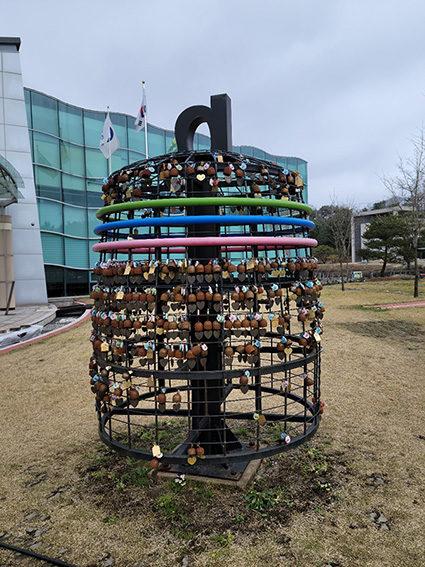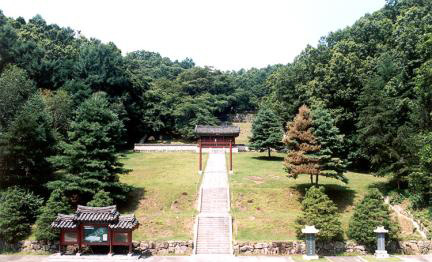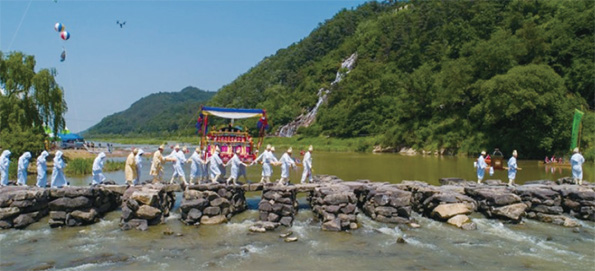This article was penned for people who feel burdened because of COVID-19. Therefore, CBT reporters recommends visiting a museum as a good example of a place where you can explore with little contact with other people. At the same time, CBNU students can have an interesting and uplifting experience to their taste. Or, it would be great to visit interesting museums in other cities with the object of exploring Korean history. If CBNU students do decide to venture out to local museum or explore museums in other cities, always be safe by wearing a mask, washing your hands, and maintaining social distancing.
There are many cities to choose from, but the CBT reporters visited Jincheon-gun, Chungcheongbuk-do, where there are many places to see and things to learn. CBNU students can easily go directly from our school to Jincheon-gun by city bus. The first place chosen for this article was the Jincheon Bell Museum in the Jincheon History Theme Park. There are many activities to do because the museum is set within the Jincheon History Theme Park. People can ring a bell yourselves at the ‘Striking a bell activity’, and post a piece of paper with your wishes written on it before ringing the bell. In the Jincheon Bell Museum, visitors can encounter the history and culture of Korean Buddhist temple bells. On the first floor, there are different categories including ‘Birth of the Bell’ and ‘Korean Buddhist Temple Bells’, so people can see various types of bells and read data about them. Also, people can learn about the characteristics of different Korean Buddhist temple bells during the unified Silla, Goryeo, Joseon dynasties by listening to the audio material provided by the museum.
On the first floor, there is a exhibition of the history of Korean Buddhist temple bells, where people can also see the production process of the bell in detail, and find out more about the bell culture of the world. It is easy to understand because there are few models explaining the production process. Also, there are activities where visitors can hear the sounds of different bells with differences in the bell components. The sound of a bell is influenced by the barrel created on the ground under it, and they make different sounds depending on whether it exists or not. Korean bells are classified as pieces of Intangible Cultural Heritage, so it is usually not permissible to ring them and therefore not easy to hear the sound of Korean bells. However, in the Jincheon Bell Museum, visitors can hear recordings of the sound of each bell or watch a short video about Korean bells. In the last exhibition room, bells from all over the world are displayed showing the beauty itself. Bells are not used in daily life now, but it can be a chance to experience other cultures and one of the methods to express artistry. They can be made in the shape of a flower and have a unique pattern on the surface with several colors. Visitors can experience all of these in the Jincheon Bell Museum. That means Jincheon Bell Museum contains the past, present, and even the future of Korean bells.
Be aware that Jincheon Bell Museum is usually closed on Mondays and public holidays. The operating hours are from 10 a.m. to 6 p.m. every day and the entrance fee is very cheap considering the huge variety of things to see. The admission fee for adults is 1,500 won and for kids is 500 won, and you can get a group discount. Outside of the museum, there is a park that offers games and missions for kids to participate in, so it is good to visit as a family. Visitors may also look around the art shop on the first floor, where visitors may buy a variety of bell ornaments including paper models of bells. If CBNU students have some more time the CBT reporter recommends visiting the Jincheon County Museum of Life Engraving Art and Cast-Iron Market Training Center.
[ Gilsangsa ]
If visitors walk down the path lined with green ginkgo trees in May, visitors can see Gilsangsa where General Kim Yu shin’s tomb is located. Kim Yu-shin is a famous Silla general who unified three countries, Goguryeo, Baekje, and Silla. Gilsangsa consists of an ancestral shrine, Heungmujeon, Inner Three Gates, and a side door. The Shrine is located at the top of a steep staircase. Before climbing the stairs, visitors can see a plaque honoring Kim Man-hee’s virtue and another plaque explaining that Gilsangsa was relocated here from its original spot.
According to Sinzeung-dongkuk-yeoji-seungram, a book about the humanities and geography of the mid-Joseon dynasty, people built a shrine named Kyeyangmyo in the middle of the mountain where Kim Yu-shin's placenta had been buried. However, it was destroyed twice during the Japanese invasion of Korea in 1592 and the Second Manchu Invasion in 1636. Therefore, Jukkyeosa, a temple was built at Gajuk, Jincheon in 1851. Not long after, it was demolished at the command of Heongsun, the ruler of Joseon. However, two years later, Kyeoyangmyo was constructed in the same location in 1866 but it closed after a few years. Then, Seobalhan shrine was built on the ridge, 198 meters southwest of Dodang Mountain and it is said that there were wooden statues of Kim Yu-shin, his wife, Ji-so, and his parents. This shrine was destroyed by a flood in 1922. In 1926, Kim Man-hee, one of the descendants of Kim Yu-shin rebuilt a temple on the ridge of Dodang Mountain and named it Gilsangsa
Two secrets are hidden in this Gilsangsa Temple. One is that Heungmujeon, which is the main building, is actually made of concrete. The building is built with concrete structures, consisting of 5 rooms in front and 2 rooms inside. When Gilsangsa was renovated, wood was mainly used as fuel in Jincheon. As a result, lots of mountains became bald so the government prohibited logging. On the other hand, industrialization and the supply of concrete lead to an increase in the number of concrete buildings. Therefore, Heongmujeon was built with concrete. The other secret is that the portrait in Gilsangsa is an imaginary drawing based on the photos of about 50 Gimhae Kims, descendants of General Kim Yu-shin. Gilsangsa Temple is a very attractive place not only for its historical value but also for its beautiful trail with beautiful old trees.
[ Nongdari ]
Nongdari is called a bridge with a thousand-year history. This is because it is assumed that the bridge was built a thousand years ago. There are some theories about the construction of the bridge. One is that the bridge was built by General Kim Seo-hyun, the father of General Kim Yu-shin, Another is that it was built by Im Hui in early Goryeo, or by Im Yeon in late Goryeo. It is more commonly believed to have been constructed by General Im Hui of the early Goryeo Dynasty and reconstructed by General Im Yeon of the late Goryeo period according to the literature records (Joseon Hwan Yeo Seung-ram, Sangsanji).
Nongdari was constructed according to the principle of yin and yang by using red stones to ensure harmony and balance. The upper part of the bridge has 28 gigantic blocks, the same as the number of constellations. Each sluice gate has one extended stone so they look like stretched bows. The pier was made of natural stones having oval and fish scale shapes, minimizing water resistance, and maximizing adhesion by pressing them together with upper plate stones. Therefore, it could stand for a long span of time and became the oldest and large bridge in Korea. It has long been heralded as an example of Korean civil engineering excellence handed down from generation to generation.
In May, the Saeng-geo Jincheon Nongdari Festival, which runs for only three days every year, is held. Originally it featured such events as the rituals for a god who had built Nongdari, crossing the bridge of hope, and the reenactment of a traditional funeral.
Even though it is expected to be greatly reduced due to COVID-19, there are still many events on offer such as a drawing contest, the Geongji fishing contests, and a writing contest. It is a short yearly festival, but you can experience the unique traditional atmosphere of Nongdari if they participate.
Other than the attractions that were introduced in this article, there are many meaningful places where people can experience the historical atmosphere in Jincheon, such as Songgang Jung-cheol's Songgangsa, Sungyeolsa, Botapsa, and the birthplace of Lee Sang-cheol. How about visit Jincheon, the perfect place to refresh your body and mind with a light outing?
By Yang Jin-a l 2016020101@cbnu.ac.kr
By Kim Ji-soo l sixteen@cbnu.ac.kr


 All
All Experience
Experience






 Yang Jin-a&Kim Ji-soo
Yang Jin-a&Kim Ji-soo











